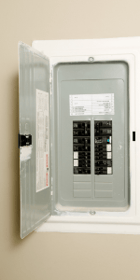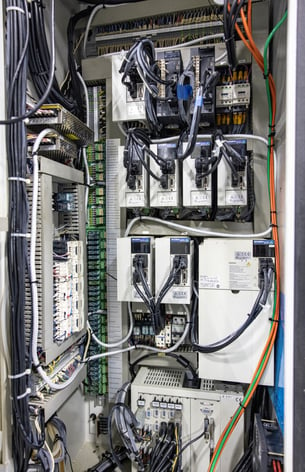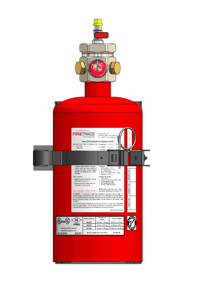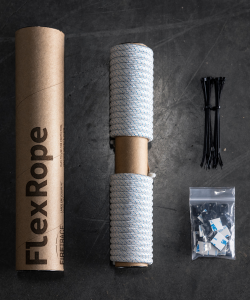While a clean agent system is crucial for protecting your electrical panel, there are additional measures you should take to enhance fire safety. This article will cover different types of electrical fire protection, necessary electrical room requirements, and selecting the best fire suppression system for your commercial space. By understanding these components, you can lower the risk of injuries, fatalities, and financial losses while ensuring prompt recovery after a fire event.
How Are Electrical Circuits Protected From Fires?
Circuit breakers, circuit interrupters, and fire-resistant materials are all defenders against electric circuit fires. 
- Circuit breakers are automatic safety devices that protect electrical circuits. They also protect appliances from damage caused by an overload or short circuit. When a short circuit or overload occurs, the circuit breaker will automatically trip, interrupting the flow of electricity and preventing a fire. Learn more about "How Do Electrical Fires Start?" here.
- Arc fault circuit interrupters (AFCIs) detect electrical arcs. Electrical arcs are a type of electrical discharge that occur when there is a faulty connection in a circuit. Arcs can generate high temperatures that ignite nearby materials, leading to a fire. When an AFCI detects an electrical arc, it stops the flow of electricity, thus preventing a fire.
- Ground fault circuit interrupters (GFCIs) protect people from electrical shocks by detecting ground faults. These occur when electricity escapes from the intended path and travels through a person's body to the ground. When a ground fault is detected, the GFCI will quickly interrupt the flow of electricity, preventing electrocution.
- Fire-resistant materials slow down or prevent the spread of fire. In electrical circuits, these materials protect the components of the circuit from overheating and potentially causing an electrical fire. Fire-resistant materials include steel and aluminum conduits, metal boxes, and fire-retardant coatings. Find out how to prevent electrical fires here.
What Characteristics of Gaseous Agents Make Them Desirable as Suppression Agents?
Gaseous agents have several desirable characteristics that make them an excellent choice for protecting electrical panels, including the following:
- No Residue - Gaseous agents do not leave any residue, so facilities can use them in areas where they want to minimize cleanup and damage. This benefit is particularly important in data centers and other areas with sensitive equipment.
- Total and Fast Flooding of an Area - Gaseous agents can be discharged quickly and fill an entire room or space, which is especially helpful for large areas.
- Safe for Use Around Humans - While some gaseous agents can be dangerous to humans if released in high concentrations (such as CO2), many gaseous agents used for fire suppression are safe for humans.
- Effective for Different Types of Fires - Gaseous agents are effective at extinguishing different types of fires, such as Class A, Class B, and Class C fires.
- Quick and Automatic Activation - Fire suppression systems can activate gaseous agents quickly and automatically, which is ideal in the event of a fire.
Is Fire Protection Required in Electrical Rooms?
Yes, fire protection is required in electrical rooms per the National Electrical Code (NEC) and National Fire Protection Association (NFPA) guidelines. The NEC sets the bar for electrical safety, and several local and state governments follow it in the U.S. Meanwhile, the NFPA, a non-profit entity, is responsible for developing codes and standards for fire safety. Though not legally enforceable unless adopted by a government agency, NFPA codes and standards are regarded as industry best practices.
What are the NEC requirements for electrical rooms? Some examples of NEC electrical room fire protection requirements include:
- Using fire-resistant materials for building electrical rooms
- Keeping the room clear of combustible materials
- Designing the room with adequate ventilation to prevent the buildup of flammable gases
- Maintaining all electrical equipment in the room according to code
- Including adequate clearance around the equipment for maintenance and emergency access
The NFPA covers a broader range of fire safety topics that the NEC does not address. What is the NFPA requirement for electrical rooms? Here are a few examples to illustrate:
- NFPA 2001 - Standard on Clean Agent Fire Extinguishing Systems | Clean agent fire suppression systems are essential for safeguarding high-value assets in sensitive areas, such as data centers, museums, and telecommunications facilities, where traditional water-based systems are unsuitable. NFPA 2001 covers all aspects of clean agent fire suppression systems, including installation, design, and maintenance.
- NFPA 75 - Fire Protection for Information Technology (IT) Equipment | The purpose of NFPA 75 is to reduce the risk of fire damage to IT equipment, which can result in significant data loss and business interruption. One of the key requirements of NFPA 75 is installing a reliable and effective electrical panel protection systems, such as a clean agent system.
Which Fire Suppression Systems Are Most Effective for Commercial Application?
The most effective electrical panel protection systems for commercial applications depend on the specific needs and requirements of the facility. However, some popular options include the following:

- Self-Contained Tube-Style Fire Suppression Systems - These systems use flexible tubing that ruptures when exposed to a fire, releasing a dry chemical, foam agent, or aerosol to extinguish the flames. Tube-style systems such as FlexRope are highly effective in small electrical settings, such as server racks or electrical cabinets, as they provide localized suppression without bulky equipment or extensive installation.
- Pre-Engineered Systems - These are designed for specific applications and typically consist of pre-manufactured components that are easy to install. Pre-Engineered systems are ideal for smaller facilities or simpler fire suppression needs. Options typically include indirect and direct release systems.
- Engineered Systems - These are custom-designed to meet a facility's specific needs and typically include a range of components, such as detection systems, control panels, and suppression agents. They are highly effective in larger or more complex facilities, like data centers or manufacturing plants.

